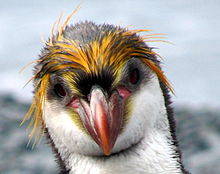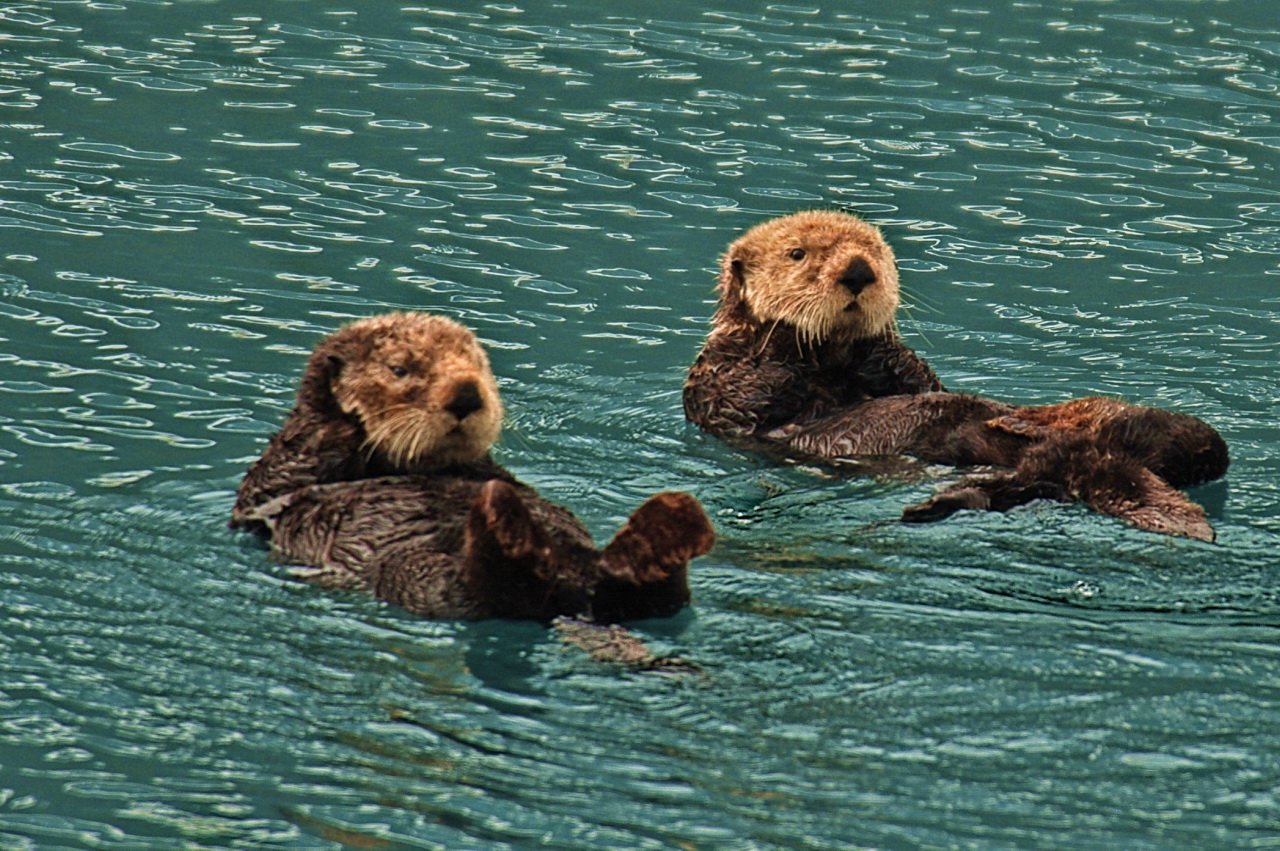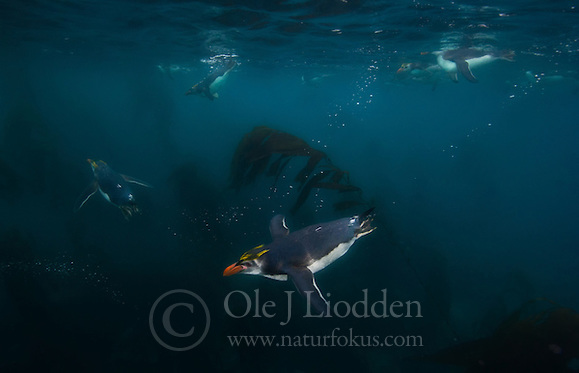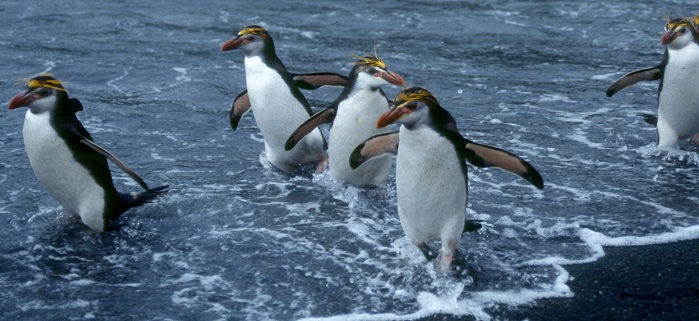Form and Function
The Royal Penguins are a species of
penguins which demonstrate great physical traits and adaptations
to fit their environment. Most species of penguins live in
frigid aquatic and coastal environments, and the Royal Penguin
is no exception. In order to sustain life in such conditions,
the Royal Penguin has been forced to adapt to survive. These
characteristics are no doubt due to environmental factors such
as extremely cold temperatures, lack of cover, scarcity of food,
and predatory influences.
In order to combat against the frigid elements of
their environment, Eudyptes schlegeli has developed a thick layer
of blubber which can be up to an inch thick (Donovan 1998.) This thick
layer of fatty tissue plays a vital role, allowing the penguins to
survive in the extremely cold water. This adaptaition is universal in
penguins, along with most marine mammals. The sea
otter (Enhydra lutris) is an exception to this, being one of
 the
only marine mammals that does not have a layer of blubber. Additionally,
along with the insulation provided by the blubber, Royal Penguins also
rely on their feathers to keep warm. The Royal Penguin’s feathers differ
from other species of penguins by being shorter and overlapping. This
allows them to be much more effective at keeping the cold water away
from their skin, because the shorter feathers are crisscrossed in a mesh
like fashion, providing a more protective layer of waterproofing. The
orientation of the feathers is important not only for providing a
barrier against the cold, but it also provides a smoother surface area.
This allows the penguins to have less drag in the water. These feathers
also display a great adaptation for the penguins because they are coated
in oil. This oil aids the penguins by keeping the water from soaking the
feathers and freezing the bodies of these birds during long swims and
dives. The oil is emitted from a gland near the tail. Yet another
adaptation can be seen in the feathers of these flightless birds when
examining the downy layer of feathers which coat the skin. The downy
layer actually traps air against the body of the Royal Penguins. This
air is then heated by the body and provides great insulation to help
keep them warm in the frigid environment.
the
only marine mammals that does not have a layer of blubber. Additionally,
along with the insulation provided by the blubber, Royal Penguins also
rely on their feathers to keep warm. The Royal Penguin’s feathers differ
from other species of penguins by being shorter and overlapping. This
allows them to be much more effective at keeping the cold water away
from their skin, because the shorter feathers are crisscrossed in a mesh
like fashion, providing a more protective layer of waterproofing. The
orientation of the feathers is important not only for providing a
barrier against the cold, but it also provides a smoother surface area.
This allows the penguins to have less drag in the water. These feathers
also display a great adaptation for the penguins because they are coated
in oil. This oil aids the penguins by keeping the water from soaking the
feathers and freezing the bodies of these birds during long swims and
dives. The oil is emitted from a gland near the tail. Yet another
adaptation can be seen in the feathers of these flightless birds when
examining the downy layer of feathers which coat the skin. The downy
layer actually traps air against the body of the Royal Penguins. This
air is then heated by the body and provides great insulation to help
keep them warm in the frigid environment.
The Royal Penguin, like other penguins, is an
extremely exceptional swimmer. They can dive up to 150 meters deep and
swim at speeds up to 20 mph (Carruthers, 2006). Some adaptations that
allow this species to swim so much faster than other species can be seen
in the feathers, bone structure, and their unique wing size. The feathers, as previously
mentioned provide an aerodynamic quality to allow for less drag in the
water. Eudyptes schlegeli also have smaller wings in respect to
their body size. This allows them to dive faster and farther than other
species. Their wings are fused straight, unlike the curvature of flying
birds such as those of Falco
peregrinus, which allows them to behave more like flippers than
traditional wings. Shorter straighter wing structure also enables them
to be more powerful and agile in the water. The Royal Penguins have
solid bones which help them to dive by acting as a ballast to help them
to descend faster, as well as providing prevention from breakage from
the stress exerted on them while swimming. The Royal Penguin also has a
streamlined body structure, which of course aids them by allowing them
to be much more agile in the water. Able to stay submerged for several
minutes, the Royal Penguin utilizes a higher level of myoglobin in the
blood stream which allows them to store more oxygen during these long
dives.
bone structure, and their unique wing size. The feathers, as previously
mentioned provide an aerodynamic quality to allow for less drag in the
water. Eudyptes schlegeli also have smaller wings in respect to
their body size. This allows them to dive faster and farther than other
species. Their wings are fused straight, unlike the curvature of flying
birds such as those of Falco
peregrinus, which allows them to behave more like flippers than
traditional wings. Shorter straighter wing structure also enables them
to be more powerful and agile in the water. The Royal Penguins have
solid bones which help them to dive by acting as a ballast to help them
to descend faster, as well as providing prevention from breakage from
the stress exerted on them while swimming. The Royal Penguin also has a
streamlined body structure, which of course aids them by allowing them
to be much more agile in the water. Able to stay submerged for several
minutes, the Royal Penguin utilizes a higher level of myoglobin in the
blood stream which allows them to store more oxygen during these long
dives.
Adult Royal Penguins do not have many land predators because they spend
most of their lives at sea (see habitat). In
order to help them avoid predators in the water, the penguin utilizes
the color of their feathers as a form of camouflage. From the depths of
the sea, these birds can be tough to spot by lurking predators such as
whales and seals because the white underbellies blend in with the
lighter surface of the water. The same type of camouflage can be seen
from the dorsal view of the swimming Eudyptes schlegeli because
the black back blends in quite nicely with the dark depths of the ocean.
Also, it is believed by many biologists that the vision of the Royal
Penguin is better underwater than on land. This helps them to find food
and locate predators while swimming.
Royal Penguins swimming underwater
